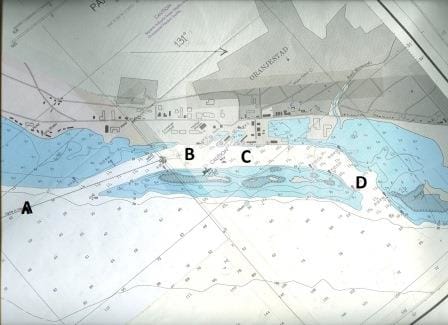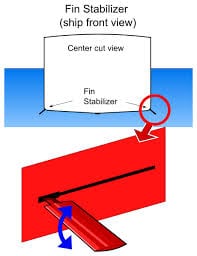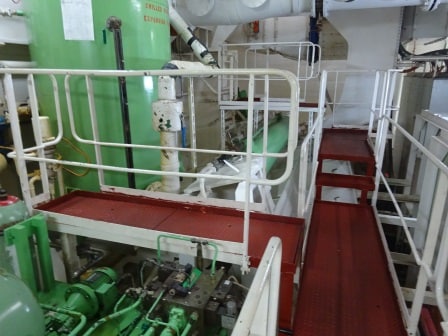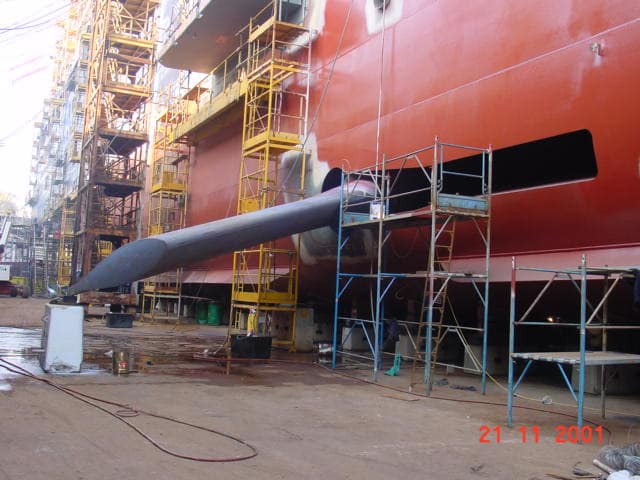It was very windy. Almost on the edge. Although the Zuiderdam is very powerful almost all the power was needed to bring the ship alongside and to keep her there while the ropes were going out. Definitely not a day for a good peace of mind situation for the captain. So when going into port, there is always the discussion and the planning for the “what if situation”. What can we do when plan A does not work? For entering the port of Oranjestad (called the Paardenbaai or Bay of Horses) we have three distinctive situations.
A. Going in or not going in. This would have been decided today by the wind or by the late departure of the Coral Princess who occupied our dock. If her guests were late, the Zuiderdam would have aborted the approach outside and made a neat circle until the coast would have been clear, or better said the dock. If the wind would have been too strong, it would have been here, 1.5 miles from the port where the captain would have said “bye bye Aruba”.
B. What if when going in, the Coral Princess suddenly stopped sailing out? Then plan B is docking at the container terminal. The crane there is broken so the container terminal is not in use at the moment but it has a very nice dock. Once there you review the situation and then you can always stay there or continue to the cruise terminal.
C. What if we come to the dock and the wind is too strong? We let ourselves blow away from the dock until clear of the Celebrity Equinox and then just continue back to open sea via the eastern exit. Once out, then you can review the situation and your options.
D. Then ensure that the pilot has a tugboat on short notice to help us to stay at point C at the next time in.

The various options in case Plan C does not work. By the time we sail out, we can call a tugboat to help us with the next attempt.
Well we kept all of that in mind, and of course we docked without much issue although the wind was strong. For that we put extra lines out, 7 headlines instead of the normal 5 and that will keep us alongside until dusk, when the wind will die down considerably and then there is no issue anymore.
To continue with our engine room exploration: Most interest always goes to the stabilizers. Main engines are fine but our guests are normally happy when they know that they are big, powerful and there are enough of them to get everybody home on time. Water in the shower is also taken for granted and also were the water goes after the shower; but what really is a constant focus are the ship stabilizers. As soon as the ship starts to roll (or wobble or whatever phrase comes to mind) the first question is, are they working? And the second question is how do they work and where are they?
Yesterday when I mentioned the crystal clear water and the shallow depth: they were visible, about 20 feet below water and sticking out about 15 feet.
 They work like an airplane wing, creating a lift under the flat of the stabilizer and directing it with the flap. If you use that lift opposite the movement of the vessel then it reduces about 90% of the rolling. It will never achieve a full 100% because the gyroscope needs the ‘push’ of the roll to react and thus there is always that little bit of movement left. Most of the time too little to be felt by the guests. The stabilizers are located in the AC or air conditioning room, which is as close to the amidships as is possible.
They work like an airplane wing, creating a lift under the flat of the stabilizer and directing it with the flap. If you use that lift opposite the movement of the vessel then it reduces about 90% of the rolling. It will never achieve a full 100% because the gyroscope needs the ‘push’ of the roll to react and thus there is always that little bit of movement left. Most of the time too little to be felt by the guests. The stabilizers are located in the AC or air conditioning room, which is as close to the amidships as is possible.
Most ships only have one set of stabilizers but some ships have two sets such as the Queen Mary 2. The logic behind it is that with the sheer bulk of this ship it might need a second set. I have spoken to officers who sailed on that ship and the combined wisdom was, nice to have two sets, always handy, but one set normally suffices.
We are staying here in Aruba until 23.00 hrs. and then sail a short hop towards Willemstad Curacao. We are scheduled for the Mega Pier which is the outside cruise dock. A longer walk for the guests into town; but still better than not getting there at all as the wind is supposed to be even stronger than today. But with the Mega pier we can dock with the wind on the nose, so we will not drift.

An this is what it looks like inside. Nothing more than a hydraulic ram with a hydraulic power pack attached to it.


Leave a Reply